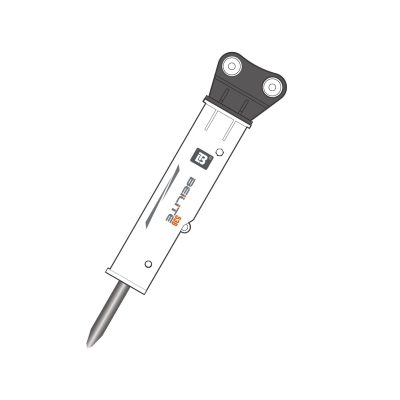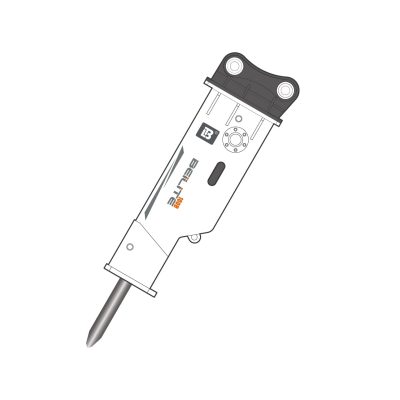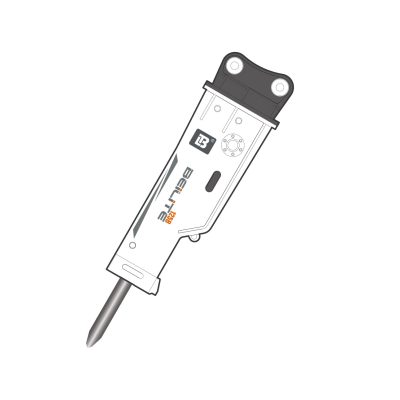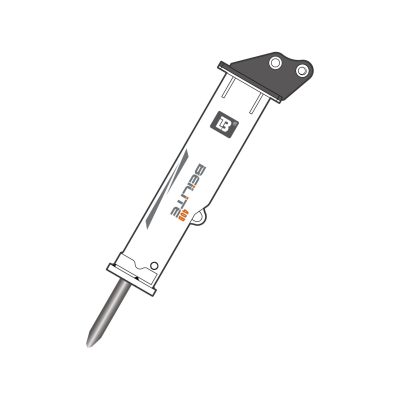What Is a Hydraulic Rock Breaker?
Construction crews often rely on hydraulic rock breakers when they face hard rock, concrete, or frozen ground. This equipment uses high-pressure oil from an excavator’s hydraulic system to drive a piston that repeatedly strikes a chisel. This impact force breaks materials that traditional methods cannot handle efficiently.

A hydraulic breaker for excavator turns the machine into a versatile demolition and trenching tool. Contractors use it in mining, road construction, and demolition sites. Because it delivers direct impact force, it works faster and causes less vibration to surrounding structures compared to alternatives like blasting or manual hammering.
Operators attach the breaker to the excavator’s boom arm. Once connected, the breaker uses hydraulic oil from the host machine to generate energy. It works well in tight areas where large tools cannot operate effectively. Many teams select this attachment for its precise control and consistent power delivery.
Core Components of a Hydraulic Rock Breaker
Every hydraulic rock breaker contains several core components that allow it to function reliably. These parts include:
1. Hydraulic Cylinder
The hydraulic cylinder converts oil pressure into motion. It houses the piston and holds the fluid that activates movement. When the excavator sends oil to the breaker, the cylinder channels it toward the piston chamber.
2. Piston
The piston remains the heart of the system. It moves back and forth inside the cylinder and strikes the chisel at high speed. This action delivers powerful blows to the material. High-grade steel and tight machining ensure the piston lasts under tough conditions.
3. Chisel (Tool or Moil Point)
The chisel directly contacts rock or concrete. It comes in different shapes for different tasks. Operators choose flat, pointed, or blunt chisels depending on the material. The chisel absorbs and transfers the piston’s energy into the surface.
4. Valve and Accumulator
The valve controls oil flow inside the breaker. It opens and closes at the right time to maintain pressure. The accumulator stores pressurized oil and smooths out pressure fluctuations during operation.
5. Housing and Mounting Bracket
The breaker’s outer casing holds all parts together and protects them from debris. The mounting bracket connects the breaker to the excavator. This bracket design determines whether the breaker fits correctly with a particular machine.
By understanding the components of hydraulic rock breaker, operators can troubleshoot issues and perform maintenance effectively.
How Does Hydraulic Rock Breaker Work?
The working process of a hydraulic rock breaker involves a repeated impact cycle driven by hydraulic power. Here’s a detailed look at how the system operates.
Step-by-Step Process
- Oil Flow Initiation
The excavator’s hydraulic pump sends oil to the breaker through high-pressure hoses. - Piston Acceleration
Inside the hydraulic cylinder, oil pressure pushes the piston backward. As the pressure builds, the valve system releases the piston, allowing it to move forward at high speed. - Impact Generation
The piston strikes the chisel or moil point. This impact generates force that fractures rock or concrete. The impact happens in milliseconds but repeats rapidly—up to several hundred times per minute. - Return Stroke
After each impact, the system resets the piston to its starting position using pressure feedback or a nitrogen charge. - Cycle Repeats
This process continues as long as the operator holds the control lever on the excavator.
This cycle represents the hydraulic breaker working principle. The breaker harnesses fluid power and mechanical movement to create high-speed impacts. This mechanism explains how hydraulic rock breakers function and why they serve well in construction and mining operations.
How Operators Use a Hydraulic Rock Breaker in the Field
Operators follow a clear sequence to use the breaker efficiently. Before use, they inspect the attachment for leaks, loose bolts, or damaged hoses. Next, they start the excavator and activate the hydraulic circuit.
Key Operating Steps
- Attach the Breaker
Workers secure the breaker to the excavator’s quick coupler or pin bracket. They connect the hydraulic lines and confirm pressure settings. - Position the Tool
The operator aligns the chisel with the material. He ensures that the tool points straight to avoid side load, which can damage the chisel and piston. - Apply Force
The excavator’s weight helps push the tool into the surface. The operator gently engages the breaker by pressing the control lever. The chisel starts delivering rapid blows. - Break Material and Move
After breaking a section, the operator lifts the chisel and repositions it. This process repeats until the job finishes.
Following proper steps prevents damage and improves efficiency. Knowing how to use a hydraulic rock breaker ensures longer tool life and safer operation.
Where Do Construction Teams Apply Hydraulic Rock Breakers?
Teams use hydraulic rock breakers across multiple industries. These tools offer unmatched versatility and strength in demanding conditions.
Common Applications
- Mining
Breakers reduce oversized rocks that block crushers. Miners also use them to create access roads or break ore underground. - Road Construction
Workers break old pavement and dig trenches for pipes or cables. Breakers work well for asphalt and concrete removal. - Demolition
Contractors remove reinforced concrete walls, foundations, or columns. The breaker delivers force without requiring full machine relocation. - Tunneling and Foundations
Engineers use breakers to break boulders or hard layers while digging deep foundations.
These examples show the wide range of hydraulic rock breaker applications, from civil projects to heavy-duty mining operations.
Maintenance for Long-Term Use and Safety
A hydraulic rock breaker must stay in good condition to deliver consistent performance. Regular maintenance extends its life and reduces breakdowns.
Daily Tasks
- Check for Leaks
Before work, operators inspect hoses and fittings. They tighten any loose connections and replace damaged parts. - Lubricate Chisel
Grease between the chisel and bushing reduces friction. Workers should apply lubricant every few working hours. - Inspect Mounting Bolts
Loose bolts cause vibration and damage. Workers check torque settings frequently.
Weekly Checks
- Clean Accumulator Valve
Dust and grime can block oil flow. Cleaning prevents performance loss. - Check Nitrogen Pressure
The nitrogen chamber helps drive the piston. Workers measure pressure and refill if it drops below the recommended level.
Monthly Service
- Replace Worn Bushings
Worn parts cause tool misalignment. Regular replacement prevents damage to the piston. - Test Hydraulic Flow and Pressure
Technicians use a flow meter to confirm the breaker receives proper oil volume and pressure.
These steps form part of a solid hydraulic rock breaker maintenance routine. Operators who follow them avoid costly repairs and delays.
Why Construction Projects Use Hydraulic Rock Breakers
Teams choose hydraulic rock breakers for many reasons. These tools help meet deadlines, improve safety, and handle hard materials.
Advantages
- High Impact Power
The breaker delivers controlled, repetitive blows. It breaks hard surfaces more quickly than manual tools. - Reduced Manual Labor
Workers stay inside the cab while the machine handles impact work. This setup protects workers from debris and fatigue. - Precise Operation
Operators control pressure and direction accurately. This precision makes breakers ideal for work near utilities or structures. - Ease of Attachment
Breakers fit most excavators. Switching attachments takes minutes, allowing teams to respond to different tasks.
Because of these advantages of hydraulic rock breakers, project managers rely on them to meet productivity goals without compromising safety.
Summary of Hydraulic Breaker Functions and Benefits
Hydraulic rock breakers use oil-powered pistons to deliver repeated blows to concrete, stone, or asphalt. These tools attach to excavators and allow operators to break hard surfaces without explosives or manual hammers. The hydraulic breaker working principle focuses on converting fluid pressure into motion. This process explains how hydraulic rock breakers function and why they remain essential in heavy construction and mining.
Operators who follow proper use and hydraulic rock breaker maintenance routines enjoy long-lasting performance. Teams across industries depend on these machines to remove obstacles, break ground, and demolish old structures.
Take the Next Step with Beilite Hydraulic Breakers
If you manage construction or mining projects and seek power, precision, and compatibility with medium excavators, Beilite has the right solutions. Contact our team to explore our full line of hydraulic breakers for excavator use. Let us help you select the best model for your workload and site demands.
Frequently Asked Questions
Q1: How does a hydraulic breaker attach to an excavator?
Operators mount the breaker using a quick coupler or pin bracket. They connect two hydraulic hoses to the auxiliary circuit and check flow settings before operation.
Q2: What kind of hydraulic oil do rock breakers use?
Breakers use ISO 46 or ISO 68-grade hydraulic oil. It must meet OEM standards and provide stable viscosity across temperature changes.
Q3: How often should I maintain a hydraulic breaker?
Daily inspections include checking for leaks, greasing, and examining bolts. Weekly and monthly checks focus on pressure, flow, and wear parts.
Q4: Can one hydraulic breaker fit different excavators?
Some breakers fit multiple machines with adapter plates or quick couplers. Still, users must match flow, pressure, and weight class to avoid damage.









